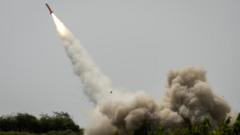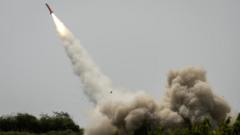In an unprecedented insight, BBC reporters explore the operational heart of the US Space Force at Buckley Base in Colorado, where Guardians track global missile launches and prepare for potential conflicts in space. With growing threats from nations like China and Russia, the Space Force adapts its strategies and technologies to maintain military superiority.
Inside the US Space Force: Guardians of Global Missile Tracking

Inside the US Space Force: Guardians of Global Missile Tracking
Exclusive access to Buckley Space Force Base reveals the intense training and operations conducted by Guardians who monitor missile threats worldwide.
At Buckley Space Force Base, nestled in the suburbs of Denver, a group of military personnel known as Guardians is engaged in a critical mission: tracking missile launches from around the globe. These service members monitor high-tech equipment in a purpose-built operations room, a rare tour allowed by the BBC as international journalists to witness the cutting-edge technology and tactics involved in missile warning and tracking.
The Guardians operate around the clock, equipped with extensive data from military satellites. During a recent drill, when the call went out to "Launch Yemen," they synchronized swiftly, showcasing the regimented precision that defines their work. Just last month, they were engaged in serious operations, tracking missile threats from Iran aimed at US forces in Qatar, a response to prior military strikes. Colonel Ann Hughes recounted the gravity of that day, emphasizing the importance of their role in protecting troops through timely intelligence.
The operations at Buckley are part of an overarching strategy tied to President Trump's ambitious plan for a missile defense shield, the Golden Dome, intended to protect the US from increasingly sophisticated threats, particularly from adversaries like China and Russia, both developing advanced missile capabilities. Lieutenant General David Miller highlighted the necessity for space-based defenses as conventional missile intercept strategies become increasingly complex.
Amid growing tensions, both China and Russia have showcased their military capabilities in space, including anti-satellite missile tests. At the same time, the concept of space as a warfighting domain has taken root since the establishment of the Space Force five years ago. Colonel Phoenix Hauser noted that space is becoming congested with thousands of satellites, requiring vigilance and readiness for potential conflict in this uncharted territory.
The rapid evolution of satellite technology is alarming; with around 12,000 satellites currently in orbit, that number could expand to tens of thousands by the decade's end. Close engagements with adversarial satellites, equipped with jamming technology and offensive capabilities, are becoming commonplace, indicating a new era of conflict that US Space Force must prepare for.
The Guardians, who once operated under the public radar, are now integrating offensive capabilities into their strategic planning. General Miller stressed the importance of maintaining strength and readiness, given the critical role space operations play in the success of ground operations—demonstrated most recently during the US operation against Iran's nuclear program.
As the newest branch of the military, the Space Force is becoming a cornerstone of US defense, with General Miller asserting that continued dominance in space is vital for the overall effectiveness of military operations. The future of US military power may very well depend on the Guardians' ability to navigate the complex and increasingly contested domain of space warfare.



















